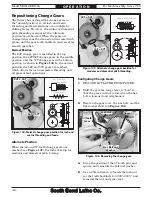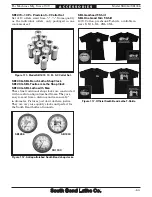
For Machines Mfg. Since 7/09
Model SB1016/SB1036
-73-
M A I N T E N A N C E
Cutting Fluid System
The cutting fluid system holds 6
1
⁄
2
gallons. A
pump pulls fluid from the tank and sends it to
the valve, which controls the flow of cutting fluid
through a universal hose and nozzle. When the
valve is opened or closed, the fluid flows from the
nozzle and drains into the chip drawer and into
a catch tray that directs it back into the tank.
Figure 131
shows many of these components
and their locations.
When swarf from machining operations falls
into the chip drawer, most of it will stay there.
However, some fine metal particles and chips
are suspended by the cutting fluid and will wash
into the tank via the catch tray. Once in the
tank, these fine metal particles and shavings will
settle, and cleaner cutting fluid will be drawn in
by the pump.
Keep in mind that the metal particles from many
types of metal sit at the bottom of the tank and
the fluid can become very toxic and poisonous.
To maintain safety and pump life, cleaning the
system on a regular basis is mandatory.
Figure 131. Cutting Fluid system components and
locations.
Nozzle
Pump Switch
Valve
Vented Tank Cover Removed
for Pump & Tank Access
Chip
Drawer
Catch Tray
BIOLOGICAL & POISON
HAZARD!
Use the correct personal
protection equipment
when handling cutting
fluid. Follow federal, state,
and fluid manufacturer
requirements for proper
disposal.
Adding Fluid
1.
DISCONNECT LATHE FROM POWER!
2.
Remove the vented tank cover to access the
cutting fluid tank (see
Figure 131)
and
observe the fluid level in the tank when
adding fluid.
3.
Pour your pre-mixed cutting fluid in the
chip drawer until the tank is nearly full and
reinstall the vented cover.
Hazards
As some cutting fluid ages, dangerous microbes
can proliferate and create a biological hazard.
The risk of exposure to this hazard can be greatly
reduced by replacing the old cutting fluid as
indicated by the fluid manufacturer.
The important thing to keep in mind when
working with cutting fluid is to minimize
exposure to your skin, eyes, and respiratory
system by wearing the proper PPE (personal
protection equipment), such as splash-resistant
safety glasses, long-sleeve gloves, protective
clothing, and a NIOSH approved respirator.
Splash Guard











































